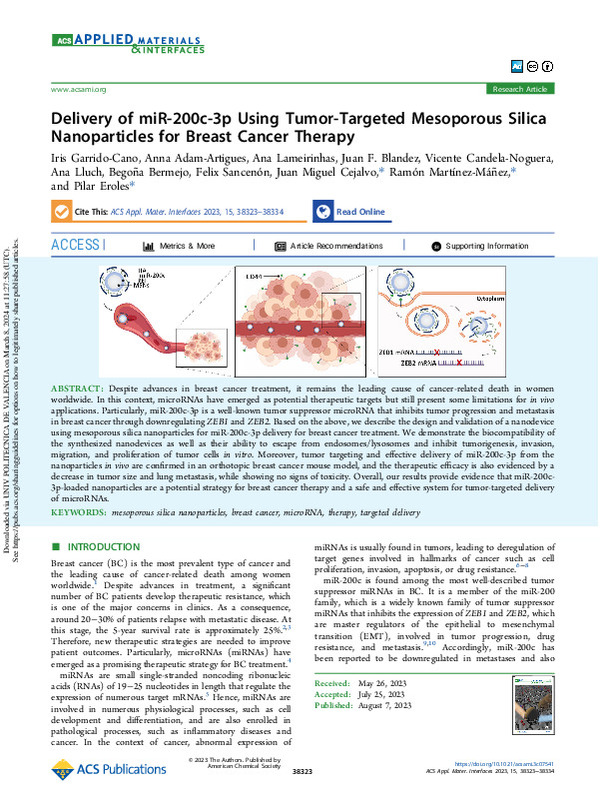Garrido-Cano, I.; Adam-Artigues, A.; Lameirinhas, A.; Blandez, JF.; Candela-Noguera, V.; Lluch, A.; Bermejo, B.... (2023). Delivery of miR-200c-3p Using Tumor-Targeted Mesoporous Silica Nanoparticles for Breast Cancer Therapy. ACS Applied Materials & Interfaces. 15(32):38323-38334. https://doi.org/10.1021/acsami.3c07541
Por favor, use este identificador para citar o enlazar este ítem: http://hdl.handle.net/10251/203426
|
Título:
|
Delivery of miR-200c-3p Using Tumor-Targeted Mesoporous Silica Nanoparticles for Breast Cancer Therapy
|
|
Autor:
|
 Garrido-Cano, Iris
Adam-Artigues, Anna
Lameirinhas, Ana
Garrido-Cano, Iris
Adam-Artigues, Anna
Lameirinhas, Ana

 Blandez, Juan F.
Blandez, Juan F.
 Candela-Noguera, Vicente
Lluch, Ana
Bermejo, Begoña
Candela-Noguera, Vicente
Lluch, Ana
Bermejo, Begoña

 Sancenón Galarza, Félix
Cejalvo, Juan Miguel
Sancenón Galarza, Félix
Cejalvo, Juan Miguel

 Martínez-Máñez, Ramón
Eroles, Pilar
Martínez-Máñez, Ramón
Eroles, Pilar
|
|
Entidad UPV:
|
Universitat Politècnica de València. Escuela Técnica Superior de Ingenieros Industriales - Escola Tècnica Superior d'Enginyers Industrials
|
|
Fecha difusión:
|
|
|
Resumen:
|
[EN] Despite advancesin breast cancer treatment, it remainsthe leadingcause of cancer-related death in women worldwide. In this context,microRNAs have emerged as potential therapeutic targets but stillpresent some limitations ...[+]
[EN] Despite advancesin breast cancer treatment, it remainsthe leadingcause of cancer-related death in women worldwide. In this context,microRNAs have emerged as potential therapeutic targets but stillpresent some limitations for in vivo applications.Particularly, miR-200c-3p is a well-known tumor suppressor microRNAthat inhibits tumor progression and metastasis in breast cancer throughdownregulating ZEB1 and ZEB2. Basedon the above, we describe the design and validation of a nanodeviceusing mesoporous silica nanoparticles for miR-200c-3p delivery forbreast cancer treatment. We demonstrate the biocompatibility of thesynthesized nanodevices as well as their ability to escape from endosomes/lysosomesand inhibit tumorigenesis, invasion, migration, and proliferationof tumor cells in vitro. Moreover, tumor targetingand effective delivery of miR-200c-3p from the nanoparticles in vivo are confirmed in an orthotopic breast cancer mousemodel, and the therapeutic efficacy is also evidenced by a decreasein tumor size and lung metastasis, while showing no signs of toxicity.Overall, our results provide evidence that miR-200c-3p-loaded nanoparticlesare a potential strategy for breast cancer therapy and a safe andeffective system for tumor-targeted delivery of microRNAs.
[-]
|
|
Palabras clave:
|
Mesoporous silica nanoparticles
,
Breast cancer
,
MicroRNA
,
Therapy
,
Targeted delivery
|
|
Derechos de uso:
|
Reconocimiento (by)
|
|
Fuente:
|
ACS Applied Materials & Interfaces. (issn:
1944-8244
)
|
|
DOI:
|
10.1021/acsami.3c07541
|
|
Editorial:
|
American Chemical Society
|
|
Versión del editor:
|
https://doi.org/10.1021/acsami.3c07541
|
|
Código del Proyecto:
|
info:eu-repo/grantAgreement/AEI/Plan Estatal de Investigación Científica y Técnica y de Innovación 2021-2023/PID2021-126304OB-C41/ES/NUEVOS MATERIALES Y SONDAS PARA EL RECONOCIMIENTO, LIBERACION DE FARMACOS, NANOMOTORES Y COMUNICACION/
...[+]
info:eu-repo/grantAgreement/AEI/Plan Estatal de Investigación Científica y Técnica y de Innovación 2021-2023/PID2021-126304OB-C41/ES/NUEVOS MATERIALES Y SONDAS PARA EL RECONOCIMIENTO, LIBERACION DE FARMACOS, NANOMOTORES Y COMUNICACION/
info:eu-repo/grantAgreement/GVA//MFA%2F2022%2F049/
info:eu-repo/grantAgreement/GVA//CIPROM%2F2021%2F007/
info:eu-repo/grantAgreement/ISCIII//CD19%2F00038/
info:eu-repo/grantAgreement/ISCIII//PI21%2F01351/
info:eu-repo/grantAgreement/ISCIII//PI18%2F01219/
info:eu-repo/grantAgreement/MINECO//CB16%2F12%2F00481//CANCER/
info:eu-repo/grantAgreement/MICINN//PRTR-C17.I1/
info:eu-repo/grantAgreement/MICINN//CB07%2F01%2F2012//Bioingeniería, biomateriales y nanomedicina/
[-]
|
|
Agradecimientos:
|
This research was supported by project PID2021-126304OB-C41 funded by MCIN/AEI/10.13039/501100011033/ and by European Regional Development Fund A way of doing Europe. Also, this study forms part of the Advanced Materials ...[+]
This research was supported by project PID2021-126304OB-C41 funded by MCIN/AEI/10.13039/501100011033/ and by European Regional Development Fund A way of doing Europe. Also, this study forms part of the Advanced Materials program (MFA/2022/049) and was supported by MCIN with funding from European Union NextGeneration EU(PRTR-C17.I1) and by Generalitat Valenciana. This study was also supported by Generalitat Valenciana (CIPROM/2021/007). This research was also supported by CIBER Consorcio Centro de Investigación Biomédica en Red CIBER-BBN(CB07/01/2012), CIBERONC(CB16/12/00481), Instituto de Salud Carlos III, Ministerio de Ciencia e Innovación. This work was also supported by Spanish Government and cofinanced by FEDER Funds (PI18/01219, PI21/01351) .I.G.-C. was funded by Margarita Salas post doctoral grant (European Union-Nextgeneration EU). A.A.-A. and A.L. were funded by Asociación Española Contra el Cancer.J.F.B. was funded by Instituto de Salud Carlos III and the European Social Fund for the financial support 'Sara Borrell' (CD19/00038). V.C.-N. was funded by Ministerio de Ciencia e Innovacio¿n (FPU grant), and J.M.C. was funded by Sociedad Española de Oncología Médica (Río Hortega-SEOM)
[-]
|
|
Tipo:
|
Artículo
|









